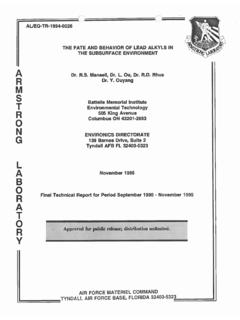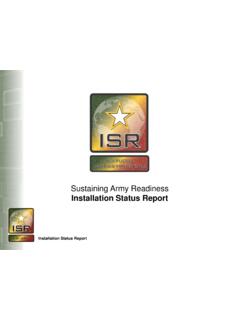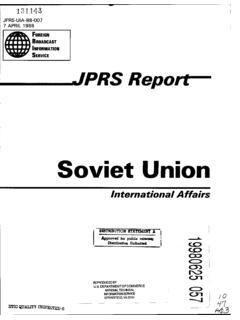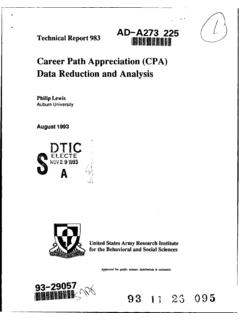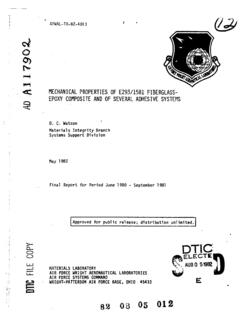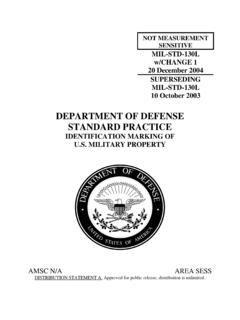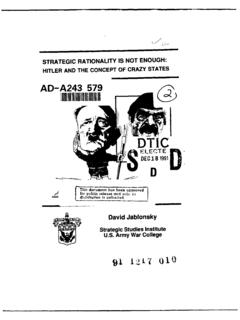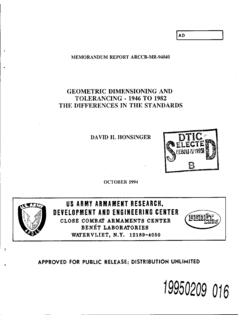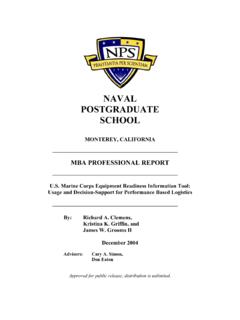Transcription of TECHNICAL REPORT NO. T08-06 DATE May 2008 ADA …
1 TECHNICAL REPORT NO. T08-06 DATEMay 2008 ADAPHYSICAL DEMANDS OF ARMY MILITARY OCCUPATIONAL SPECIALTIES:CONSTRUCTING AND APPLYING A CROSSWALK TO EVALUATE THERELATIONSHIP BETWEEN OCCUPATIONAL PHYSICAL DEMANDS ANDHOSPITALIZATIONS Approved for public release; distribution is unlimited. The opinions or assertions contained herein are the private views of the authors and are not to be construed as official or reflecting the views of the Army or the Department of Defense. The investigators have adhered to the policies for protection of human subjects as prescribed in Army Regulation 70-25, and the research was conducted in adherence with the provisions of 32 CFR Part 219. Any citations of commercial organizations and trade names in this REPORT do not constitute an official Department of the Army endorsement of approval of the products or services of these organizations.
2 / MONITORINGAGENCY REPORT PERFORMING ORGANIZATION NAME(S) AND ADDRESS(ES)Social Sectors Development Strategies, Washington St. Suite 6 Boston, MA 02118 Public reporting burden for this collection of information is estimated to average 1 hour per response, including the time for reviewing instructions, searching existing data sources,gathering and maintaining the data needed, and completing and reviewing the collection of information. Send comments regarding this burden estimate or any other aspect of thiscollection of information, including suggestions for reducing this burden, to Washington Headquarters Services, Directorate for Information Operations and Reports, 1215 JeffersonDavis Highway, Suite 1204, Arlington, VA 22202-4302, and to the Office of Management and Budget, Paperwork Reduction Project (0704-0188), Washington, DC ORGANIZATIONREPORT NUMBERREPORT DOCUMENTATION PAGEForm ApprovedOMB No.
3 0704-0188 SECURITY CLASSIFICATIONOF REPORTSECURITY CLASSIFICATIONOF THIS PAGESECURITY CLASSIFICATIONOF AGENCY USE ONLY(Leave blank)4. TITLE AND SUBTITLEP hysical Demands of Army Military Occupational Specialties: Constructing andApplying a Crosswalk to Evaluate the Relationship between Occupational PhysicalDemands and Hospitalizations6. AUTHOR(S)Ilyssa E. Hollander, Nicole S. Bell, Marilyn Sharp9. SPONSORING / MONITORING AGENCY NAME(S) AND ADDRESS(ES)US Army Research Institute of Environmental MedicineKansas St., Building 42 Natick, MA 01760-50071 1 . SUPPLEMENTARY NOTESThis work was also supported by a grant from the Army Medical Research Acquisition Activity (USAMRAA), grantnumber DISTRIBUTION / AVAILABILITY STATEMENTA pproved for public release; distribution is unlimited1 4 . SUBJECT TERMSM ilitary Occupational Specialty, Physical Demand, TAIHOD, Injury, Hospitalization, Job13.
4 ABSTRACT(Maximum 200 words)Army Military Occupational Specialties (MOSs) for enlisted Soldiers are categorized by their relative level of physicaldemands. This REPORT compares injury rates among common MOSs stratified by light, moderate and heavy levels of physicaljob demands. As hypothesized unadjusted odds for experiencing aninjury hospitalization increased with increasing level ofphysical demand. On-duty serious accidents (those resulting in an injury hospitalization) also occurred more frequentlyamong Soldiers in heavy demands jobs, with Soldiers in the heavy demands jobs of Infantrymen, Cavalry Scouts and IndirectFire Infantrymen particularly at risk for on-duty injuries. In contrast, the odds of experiencing a hospitalization for"any-cause" were lowest for Soldiers in the highest physical demands jobs, followed by moderate demands jobs, withSoldiers in light demands jobs at greatest risk for any-cause hospitalization.
5 The dynamic nature of MOS nomenclature overtime makes the study of any temporal patterns or risk factors for injury or disability within an occupational cohort REPORT documents the TECHNICAL and analytic steps taken in order to create a crosswalk for analyzing military occupationcodes over time and associations with selected health outcomes. More research is needed to explore long-term chronicconditions and disability related to occupational physical demand and to clarify the independent influence of job demandsonce demographic factors are FUNDING NUMBERS20. LIMITATION OF ABSTRACTU nclassified15. NUMBER OF PAGES4016. PRICE CODE2. REPORT DATEMay 20083. REPORT TYPE AND DATES COVEREDT echnical Report12b. DISTRIBUTION CODEU nlimitedNSN 7540-01-280-5500 Standard Form 298 (Rev. 2-89)Prescribed by ANSI Std. Z39-18 298-102 USAPPC USARIEM TECHNICAL REPORT T08-06 PHYSICAL DEMANDS OF ARMY MILITARY OCCUPATIONAL SPECIALTIES: CONSTRUCTING AND APPLYING A CROSSWALK TO EVALUATE THE RELATIONSHIP BETWEEN OCCUPATIONAL PHYSICAL DEMANDS AND HOSPITALIZATIONS Ilyssa E.
6 Hollander, MPH1 Nicole S. Bell, ScD, MPH1, 2 Marilyn Sharp, MS3 1 Social Sectors Development Strategies, Inc. Boston, MA 2 Social Sectors Development Strategies, Inc. Tacoma, MA 3 Military Performance Division Army Research Institute of Environmental Medicine Natick, MA May 2008 Army Research Institute of Environmental Medicine Natick, MA 01760-5007 TABLE OF CONTENTS SECTION PAGE LIST OF LIST OF v LIST OF EXECUTIVE 1 3 5 THE 5 THE ARMY PHYSICAL DEMANDS 5 OCCUPATIONAL 6 STUDY 7 7 Constructing the MOS Crosswalk and Linking to Job Demand 7 Association between Job Demands and Injury and Other Health 8 9 HOSPITALIZATION RISK BY MOS PHYSICAL DEMAND 13 TEMPORAL CROSSWALK OF 45 SELECTED MOS CODES, 1980 15 HOSPITALIZATIONS BY JOB DEMANDS, TOP 45 JOBS.
7 1980 19 Heavy Physical 19 Moderate Physical 19 Light Physical 19 35 STRENGTHS AND 36 CONCLUSIONS AND 38 39 iii ivLIST OF FIGURES FIGURE PAGE 1 Average Hospitalization Rates for Heavy, Moderate and Light Physically Demanding Jobs, 1980-2006 30 LIST OF TABLES TABLE PAGE 1 Crosswalk of Military Occupational Specialties with Level of Physical Demand, 2000 (N=469,292 Total Population) 11 2 MOS Physical Demand Levels (2000) and Hospitalizations Experienced within 1 Year (any reason) 13 3 MOS Physical Demand Levels (2000) and Hospitalizations Experienced within 1 Year (with Injury Diagnosis in the Primary Position) 14 4 MOS Physical Demand Levels (2000) and Hospitalizations Experienced within 1 Year (with Musculoskeletal Diagnosis in the Primary Position) 14 5 Top 15 Military Occupations for Light, Moderate and Heavy Levels of Physical Demands, 1980-2006 17 6 Rates of Injury Hospitalizations for Top 15 Heavy MOS Codes, 1980-2006 21 7 Rates of Musculoskeletal Hospitalizations for Top 15 Heavy MOS Codes, 1980-2006 22 8 Rates of Any Hospitalizations for Top 15 Heavy MOS Codes, 1980-2006 23 9 Rates of Injury Hospitalizations for Top 15 Moderate MOS Codes, 1980-2006 24 10 Rates of Musculoskeletal Hospitalizations for Top 15 Moderate MOS Codes, 1980-2006 25 11 Rates of Any Hospitalizations for Top 15 Moderate MOS Codes, 1980-2006 26 12 Rates of Injury Hospitalizations for top 15 Light MOS Codes, 1980-2006 27 13 Rates of Musculoskeletal Hospitalizations for Top 15 Light MOS Codes, 1980-2006 28 14 Rates of Any Hospitalizations for Top 15 Light MOS Codes.
8 1980-2006 29 15 Nature of Injury for Injury-related Hospitalizations among Heavy Physical Demand MOS Codes (N=97,368) 32 16 Nature of Injury for Injury-related Hospitalizations among Moderate Physical Demand MOS Codes (N=20,821) 33 17 Nature of Injury for Injury-related Hospitalizations among Light Physical Demand MOS Codes (N=9,566) 34 ACKNOWLEDGEMENTS The authors would like to thank Lauren Komp for her work linking the MOS codes over time and for running all statistical analyses. The authors would also like to thank CPT Owen Hill, TAIHOD Director, Army Research Institute of Environmental Medicine, for his guidance and continued support of this research. This work was made possible by support from a grant from the Army Medical Research Acquisition Activity; grant number W81 XWH-06-2-0028. vLIST OF ACRONYMS AP Army Pamphlet DoD Department of Defense MOS Military Occupational Specialty DMDC Defense Manpower Data Center ICD-9-CM International Classification of Disease, 9th Revision, Clinical Modification OR Odds Ratio STANAG NATO Standardized Agreement TAIHOD Total Army Injury and Health Outcomes Database viEXECUTIVE SUMMARY Army Military Occupational Specialties (MOSs) for enlisted Soldiers are categorized by their relative level of physical demands.
9 Ideally this information should be used to insure a Soldier possesses the necessary physical attributes to safely perform an assigned job. The objectives of this REPORT are to compare rates of injury among common MOSs stratified by light, moderate and heavy levels of physical job demands. We hypothesize that Soldiers placed in MOSs with higher levels of occupational physical demands will be at greatest risk for occupational injury, followed by those in moderately demanding jobs. We hypothesize that Soldiers in the least physically demanding jobs will be at lowest risk for occupational injury. A secondary objective of this REPORT is to document the TECHNICAL and analytic steps taken in order to create a crosswalk that allowed us to follow trends in military occupation codes over time. The physical demand levels of each enlisted MOS are classified and described in Department of the Army Pamphlet 611-21.
10 The Army Pamphlet also outlines the procedures for evaluating physical abilities throughout a Soldier s career to prevent mismatches between the physical demands of a job and the physical abilities of a Soldier. While there is stated intent to ensure that Soldiers are appropriately matched to occupations based on the physical requirements of a position and the physical capabilities of the individual, it is doubtful such evaluations occur. With escalating rates of musculoskeletal disability, there is cause for concern about whether Soldiers are appropriately evaluated and then placed in jobs with occupational demands suitable for their physical capabilities throughout their careers. Failure to properly match physical capabilities with physical demands of a job will likely lead to excess injury and disability. While it is expected that there will be variation in the type of injury patterns seen across various occupational specialties because of differential exposures, it is nonetheless important to understand and prevent job-related injuries.
